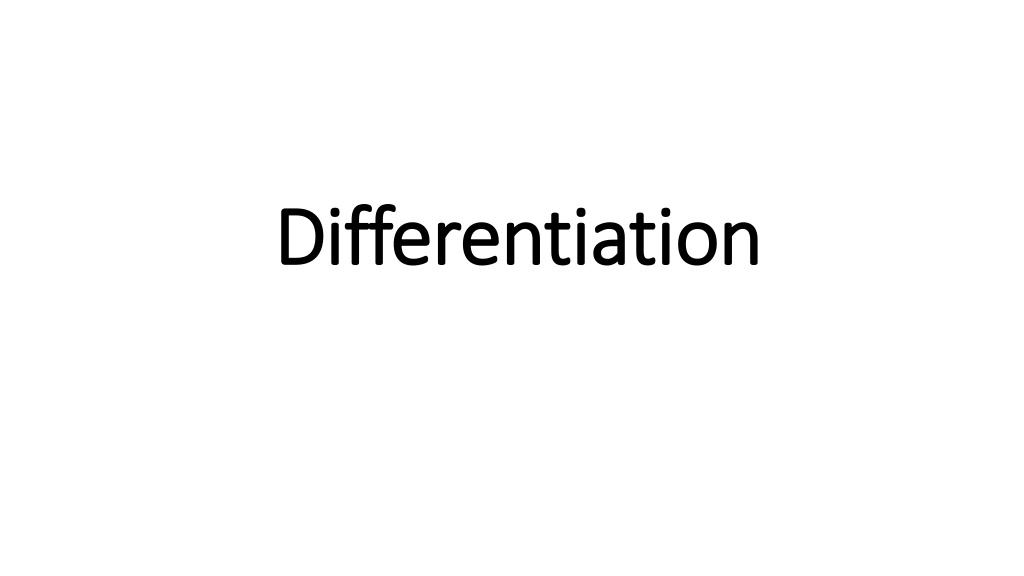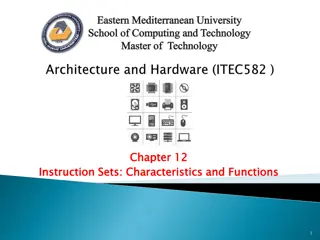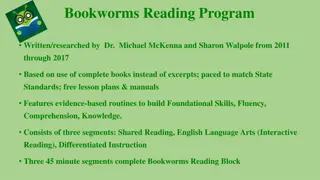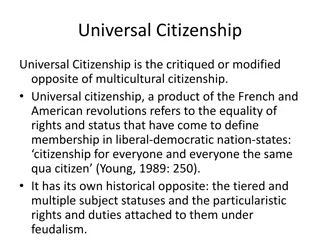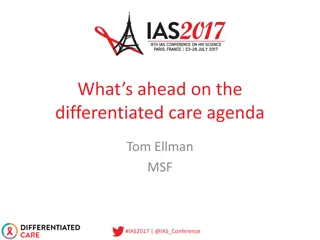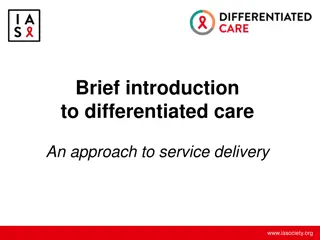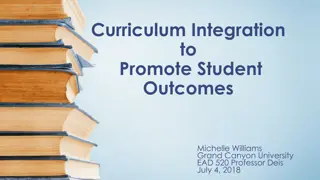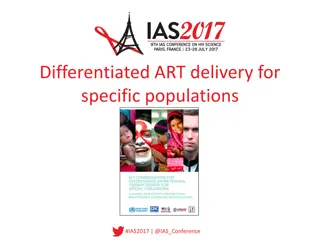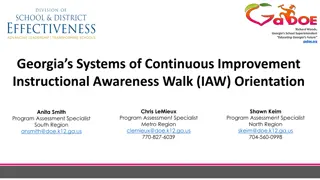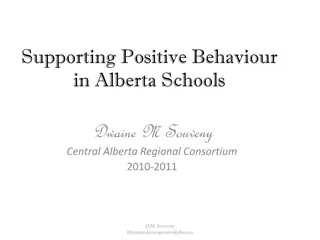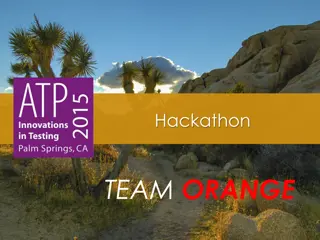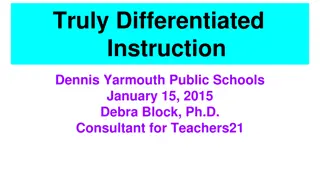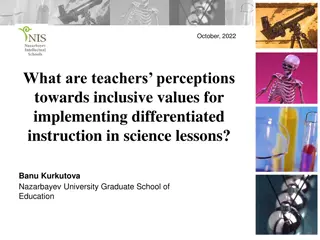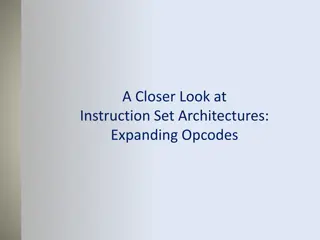Exploring the Concept of Differentiated Instruction in Education
Understanding the significance of differentiation in education where teachers respond to diverse learner needs, provide varied learning options, and create inclusive environments. This approach ensures all students have access to the curriculum through tailored instruction methods and resources. Strategies are discussed, emphasizing the importance of adapting content, process, and product based on student readiness, interest, and learning profiles.
Uploaded on Oct 11, 2024 | 0 Views
Download Presentation

Please find below an Image/Link to download the presentation.
The content on the website is provided AS IS for your information and personal use only. It may not be sold, licensed, or shared on other websites without obtaining consent from the author. Download presentation by click this link. If you encounter any issues during the download, it is possible that the publisher has removed the file from their server.
E N D
Presentation Transcript
Differentiation Differentiation
Why Differentiate? All kids are different. One size does not fit all. Differentiation provides all students with access to all curriculum. 2
What Is Differentiation? A teacher s response to learner needs The recognition of students varying background knowledge and preferences Instruction that appeals to students differences 3
Discussion Question What are you already doing to differentiate instruction in your classroom? 4
Theres an App for that! When I think of differentiation, I think of an Apple iPhone no matter what you re trying to accomplish, There s an app for that. I think of DI from the perspective of finding appropriate resources to meet a learner s needs. No matter where they are developmentally, there are resources, Strategies, and best practices to get them what they need. That s what the iPhone commercials remind me of and I love them for their resourcefulness! Amy Sherwin A teacher in Michigan
What Differentiated Instruction Means for Teachers Teachers DO Provide several learning options, or different paths to learning, which help students take in information and make sense of concepts and skills. Provide appropriate levels of challenge for all students, including those who lag behind, those who are advanced, and those right in the middle. Teachers DON T Develop a separate lesson plan for each student in a classroom. water down the curriculum for some students.
Differentiation is a teacher s proactive response to learner needs shaped by mindset and guided by general principals of differentiation A supportive Learning Environment Quality Curriculum Assessment that Informs Teaching and Learning Instruction that Responds to Student Variance Leading and Managing the Classroom Teachers can Differentiate through Content The information and ideas students grapple with in order to reach the learning goals Process Product Affect How students take in and make sense of the content How students show what they know, understand and can do The climate or tone of the classroom According to student s Readiness, Interest and Learning Profile
Content Content Utilize pre-tests to assess where individual students need to begin study of a given topic or unit Encourage thinking at various levels of Bloom s taxonomy Use a variety of instructional delivery methods to address different learning styles. Break assignments into smaller, more manageable parts that include structured directions for each part Choose broad instructional concepts and skills that lend themselves to understanding at various levels of complexity
Based on Process Based on Process Provide access to a variety of materials which target different learning preferences and reading abilities. Develop activities that target auditory, visual, and kinesthetic learners. Establish stations for inquiry-based, independent learning activities. Create activities that vary in level of complexity and degree of abstract thinking required. Use flexible grouping to group and regroup students based on factors including content, ability, and assessment results.
Based on Product Based on Product Use a variety of assessment strategies, including performance-based and open-ended assessment. Balance teacher-assigned and student-selected projects. Offer students a choice of projects that reflect a variety of learning styles and interests. Make assessment an ongoing, interactive process.
Teachers can Differentiate through a variety of instructional strategies such as Graphic Organizers Independent Projects Learning/Interest Centers Scaffolding Reading/Writing Learning Contracts Choice of Activities Small Group Instruction Tiered Assignments
Examples of Differentiation Strategies Choice Boards Tiered Activities Learning Contracts 12
Diner Menu Photosynthesis Appetizer (Everyone Shares) Write the chemical equation for photosynthesis. Entr e (Select One) Draw a picture that shows what happens during photosynthesis. Write two paragraphs about what happens during photosynthesis. Create a rap that explains what happens during photosynthesis. Side Dishes (Select at Least Two) Define respiration, in writing. Compare photosynthesis to respiration using a Venn Diagram. Write a journal entry from the point of view of a green plant. With a partner, create and perform a skit that shows the differences between photosynthesis and respiration. Dessert (Optional) Create a test to assess the teacher s knowledge of photosynthesis. 13
THINK-TAC-TOE Book Report Draw a picture of the main character. Perform a play that shows the conclusion of a story. Make a poster that shows the order of events in the story. Write a song about one of the main events. Write a poem about two main events in the story. Dress up as your favorite character and perform a speech telling who you are. Write two paragraphs about the setting. Create a Venn diagram comparing and contrasting the introduction to the closing. Write two paragraphs about the main character. 14
Tiered Activity Writing a Persuasive Essay 6th 8th Grade Classroom Beginning Intermediate Advanced Students will determine a topic and will write a five-sentence paragraph with a main idea, three supporting sentences, and a concluding sentence. Students will determine a topic, state a point of view, and write two paragraphs defending that point of view. Students will determine a topic, state a point of view, and write an essay of at least five paragraphs that uses multiple sources to defend that point of view. Outcome/ Objective Students will receive a model of a five-sentence paragraph and explicit instruction in constructing the paragraph. As a prewriting activity, students will list their topic and develop a list of at least three things that support their topic. Students will receive a model of a persuasive essay and a graphic organizer that explains the construction of a persuasive essay. Students will also receive explicit instruction in writing a persuasive essay. As a prewriting activity, students will use the graphic organizer to plan their writing. Students will review the graphic organizer for a persuasive essay. Students will be given explicit instruction in locating sources and quotes for their essays. As a prewriting activity, students will use the graphic organizer to organize their essay. Students will also compile a list of five sources that defend their main point. Instruction/ Activity Students will be able to write a five-sentence paragraph that successfully states and supports a main idea. The paragraph will meet the criteria on the state writing rubric. Students will be able to state a point of view and successfully defend the idea using two paragraphs that defend the point of view using main ideas and supporting details. The paragraphs will meet the criteria on the state writing rubric. Students will be able to write a five-paragraph essay that states a point of view, defends the point of view, and uses resources to support the point of view. The essay will meet the criteria on the state writing rubric. Assessment 15
Learning Contract #1 Name _______________________ My question or topic is: To find out about my question or topic I will read: I will look at and listen to: I will write: I will draw: I will need: Here s how I will share what I know: I will finish by this date: 16
LearningContract #2 To demonstrate what I have learned about ____________________, I want to _ Write a report _ Put on a demonstration _ Set up an experiment _ Develop a computer presentation _ Build a model _Design a mural _ Write a song _ Make a movie _ Create a graphic organizer or diagram _ Other This will be a good way to demonstrate understanding of this concept because ______________________________________________________________ To do this project, I will need help with ______________________________________________________________ My Action Plan is________________________________________________ The criteria/rubric which will be used to assess my final product is _________ ______________________________________________________________ My project will be completed by this date _____________________________ Student signature: ________________________________ Date ___/___/___ Teacher signature: ________________________________ Date ___/___/___ 17
